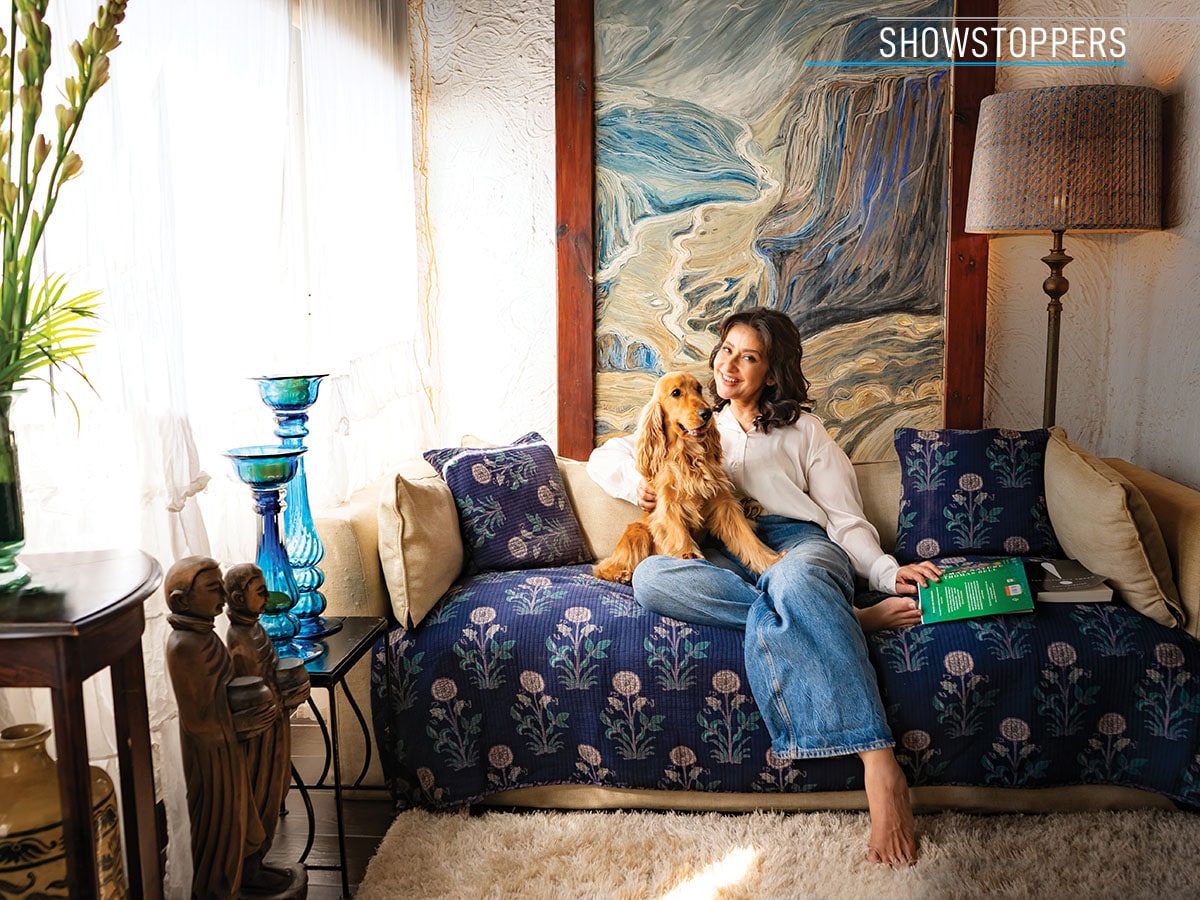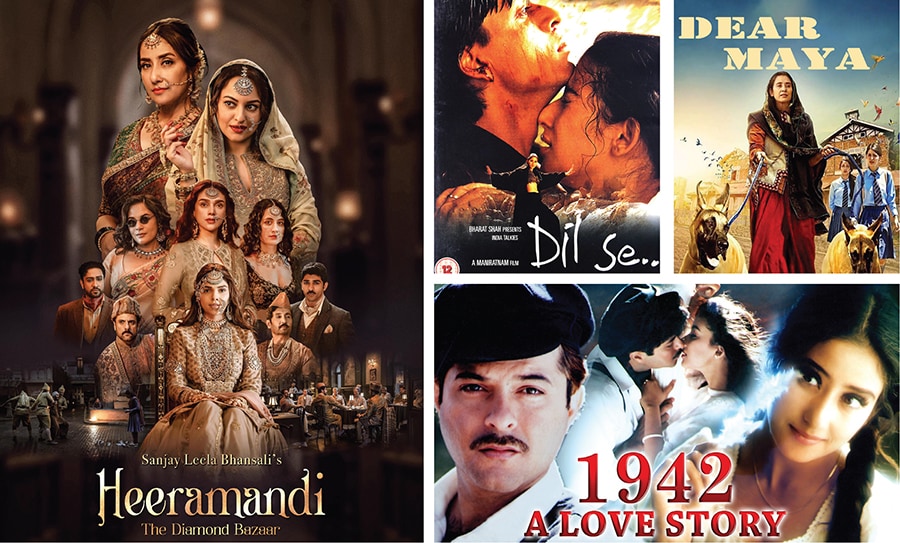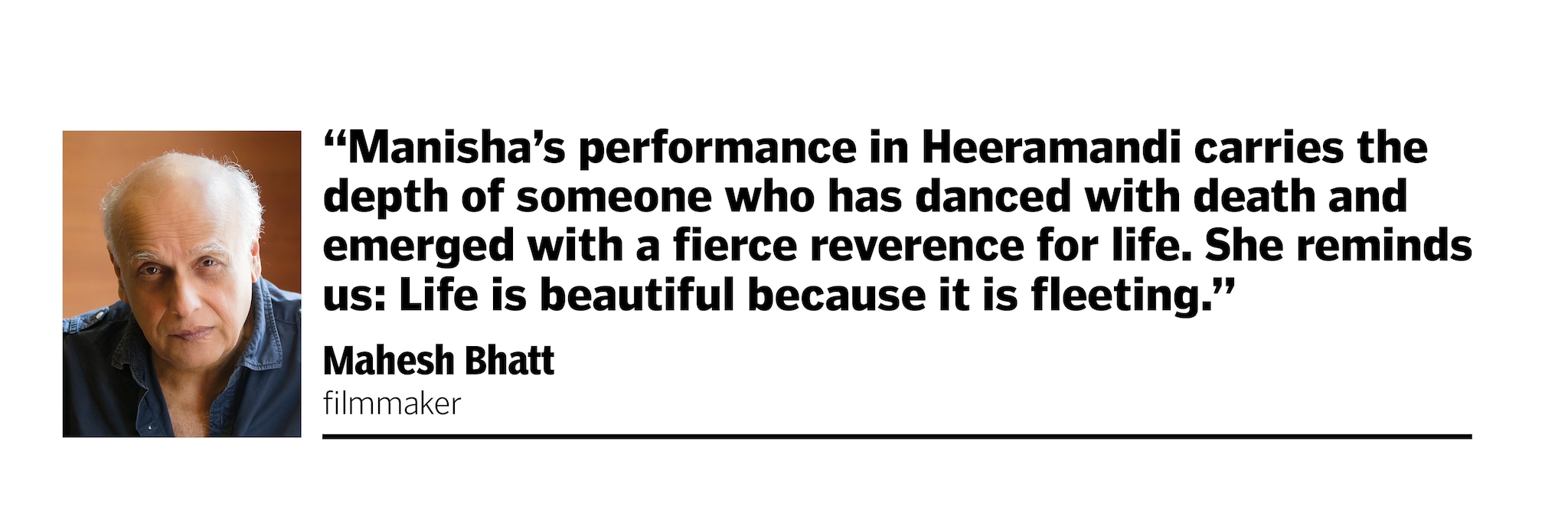 Manisha Koirala at her Mumbai home in Versova
Manisha Koirala at her Mumbai home in Versova
Image: Neha Mithbawkar for Forbes India
As you enter Manisha Koirala’s Mumbai home in Versova, you’re greeted by an unexpected yet harmonious duo: Mowgli, her energetic fur baby, and Simba, his little brother from the feline clan. The walls are adorned with stunning paintings by artists like Deepti Naval, Laila Khan and Kisalay Vora, and the fragrance of fresh white rajanigandha (tuberose) flowers wafts through the air.
Dressed in a simple and elegant white shirt paired with blue denims, Koirala radiates a sense of calm confidence. Looking back on her three-decade-long journey, the 54-year-old actor, who made her debut in the 90s iconic film Saudagar, says, “I never imagined I’d have such a long career. I thought actresses had a shelf life of 10 years, max. But here I am, 33 years later, and it feels like it’s never-ending—which is amazing.”
Koirala, who has nearly 100 films under her belt and hits like Bombay (1995), 1942: A Love Story (1994) and Dil Se (1998), made her OTT series debut with Sanjay Leela Bhansali’s Heeramandi: The Diamond Bazaar in 2024. The eight-part historical drama series, which streamed on Netflix, delves into the lives of courtesans in Lahore’s walled city during the pre-Partition era. Koirala, who played courtesan Mallikajaan, earned praise for her performance despite mixed reviews for the show.
Koirala had earlier worked with Bhansali in his 1996 debut film Khamoshi: The Musical and when he approached her for this role, she immediately agreed. “It’s one of the most challenging roles I’ve ever done,” she says adding that she found some scenes tough, especially in the beginning when she was still getting into character. She had to work hard to get the right tone and mannerisms, especially speaking Urdu, which was essential for the part.
As a cancer survivor, Koirala also knew that taking on a project like Heeramandi would be physically demanding. But she was determined to give it her all without compromising on her health. Koirala was diagnosed with stage IV ovarian cancer in 2012 and underwent treatment in the US, including surgery and chemotherapy. After a tough battle, she was declared cancer-free in 2013.
“Initially, it seemed like an impossible dream,” she says. “I was on the hospital bed, dreaming of getting a second chance at life and reviving my career,” says Koirala, who faced numerous hurdles, mostly internal. She was insecure, fearful and conscious about her appearance, having lost her hair due to chemotherapy. “I was scared and vulnerable about how people would judge me,” she admits. “I had doubts about being accepted back again.”

But undeterred, Koirala slowly started rebuilding her career. She began with a Kannada film, Game (2016), which she acknowledges wasn’t her best work. “My acting was loud, my makeup was loud,” she says with a laugh. “But I was nervous and not yet prepared.” She then took a break, waiting for the right script to come along. That’s when Dear Maya (2017) happened, a film that allowed her to pour her heart into the role of Mayadevi, an elderly woman who starts living her life again after receiving love letters from a stranger. Although the film didn’t do well, Koirala says she found a lifelong friend in director Sunaina Bhatnagar.
Koirala’s confidence grew with each new project. She worked with Rajkumar Hirani in Sanju (2018), alongside Ranbir Kapoor, landed OTT project Lust Stories in 2018 and was last seen in Shehzada, which released in 2023.
Battling career setbacks, making multiple comebacks, fighting cancer… through it all Koirala’s resilience shines through. Hailing from Nepal, Koirala came to Bollywood as an outsider and newcomer with no backing even as her debut coincided with those of Karisma Kapoor, Kajol and Rani Mukerji. “Those days, of course, there was competition, but not as cutthroat as today’s times,” Koirala reflects. “I think the 90s and 2000s were far more relaxed times. We all realised we had enough work, and we didn’t have to be overly competitive.”
There were certain hiccups that she faced as a new entrant, but Koirala never felt disadvantaged. “I was aware of the issues, and I had to face many challenges on my own,” she acknowledges. “But I never felt bad because my heart was full of what I was getting. I was focussed on trying to excel in my work.” Koirala’s mantra was simple: Work hard, enjoy life and appreciate the opportunities that come your way.
Also read: Shattering the glam doll image: How Ananya Panday took control
Today, she says, times have changed, and the film industry has evolved. “Today, everybody thinks 100 times before accepting a film,” Koirala observes. “There are so many clauses, and everyone is more cautious.” In contrast, Koirala remembers a time when actors would jump into projects without thoroughly reading contracts or worrying about the financial aspects.
The veteran actor has had the privilege of working with some of the finest actors and directors in the industry, including directors like Subhash Ghai, Ram Gopal Varma, Mansoor Khan and Mani Ratnam. One of Koirala’s most memorable experiences, she says, was working on 1942: A Love Story directed by Vidhu Vinod Chopra. “That’s where I learnt the true meaning of good acting,” she says. “I realised that acting is not just about memorising lines and delivering them, but about bringing a character to life through your voice, eyes and body language.”
Co-star Sanjay Kapoor, who first worked with her in Chhupa Rustam in 2001 and later in Anjaane in 2005, says he has seen the changes in her. “When we worked together again on Lust Stories six years ago, I noticed that she had gone through a significant personal journey. She had battled illness, but as a person, she remained unchanged. What struck me was her growth as an actor. With experience, she had become even more nuanced and effective in front of the camera.”
He adds that Koirala’s recent work in Heeramandi left him impressed. “She had fully immersed herself in the character. I’ve seen her transition over the years, she’s an inspiration, and I’m thrilled to see her thriving in her career,” he says.
Film critic Anupama Chopra concurs. When Koirala entered the scene in the 90s, her striking beauty was undeniable. However, what set her apart was her acting talent. In an era where stars and actors were often distinct, Koirala proved to be a rare combination of both. While she did appear in commercial films, she also made bold choices, selecting projects that allowed her to demonstrate her craft, she says. “It’s remarkable to see Koirala back in the spotlight. The shift to streaming platforms has created a more welcoming ecosystem for women, offering them more opportunities and better roles, especially for those over 50. This platform allows talented actresses like Koirala to shine and receive the recognition they deserve.”
Directors, actors and critics all agree that ageism is a pervasive issue in the Indian film industry, disproportionately affecting women. Once female actors reach their mid-30s, they experience a significant decline in movie offers. In contrast, their male counterparts continue to thrive well into their 50s, securing leading roles and commanding high salaries despite their advancing age. Women are often typecast in younger roles, and as they age, they are no longer considered for leading parts. This has resulted in a scarcity of meaningful roles for older women in Indian cinema, they add.
Koirala’s role in Heeramandi was one such. “It’s frustrating. But with time, people are becoming more open-minded and willing to tell stories that cater to all ages. The younger generation is more open and welcoming to diverse types of cinema, including stories about people of different ages,” says Koirala.
Filmmaker Mahesh Bhatt, who has worked with her in Criminal (1994) and Milan (1995), agrees that it’s not accurate to assume that young people are only interested in seeing themselves reflected on screen. Many young people are eager to engage with stories about older people, learning from their experiences and gaining new perspectives, he says, adding that the film industry needs to wake up and pursue stories that reflect the diversity of human experience. “As people age, they accumulate depth, experience and wisdom, but the industry’s youth-obsessed culture often overlooks this. This phenomenon is not unique to India, it’s prevalent in the entertainment world globally,” he adds. “When the industry becomes more courageous in telling diverse stories, there will be a greater need for talented actors who can bring these stories to life.”
Koirala’s journey, he says, has so far not just been about fame but also about personal growth and resilience. “A good actor’s defining attribute is vulnerability, which is, in essence, courage. Koirala embodies this vulnerability, making her a fine actor. Her personal journey, ups and downs, including her battle with cancer, has had a profound impact on her,” he says. “In a culture that often denies mortality and transience, Manisha’s encounter with death has given her a unique perspective. This experience has enriched her acting, making her performances more nuanced and authentic,” adds Bhatt.
Speaking about pay disparity, Koirala also firmly believes it’s unfair to pay actors more than actresses when they’re doing the same job. “An actress is equally crucial to a film’s success, so it’s illogical to pay her less.” The common argument is that a film’s success hinges on the actor’s popularity, but Koirala argues that if actresses were given the same importance and opportunities, they would achieve equal success. “It’s essential that we work towards correcting these inequalities and elevating the industry’s standards.”
As we wrap up our conversation, Koirala’s furry babies, Mowgli and Simba, can’t help but snuggle up close to her. And with a renewed sense of purpose and a deeper appreciation for life, she says she’s ready to make the most of her recent comeback.
